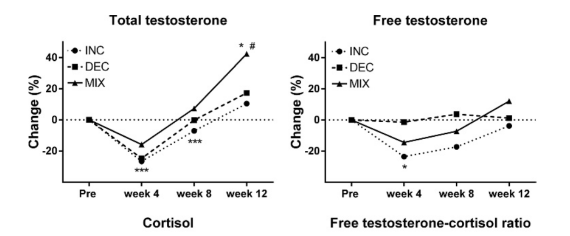Hi @robertehall1,
There was no significant difference between the two groups at the end of the 12 weeks, so this really comes down to your interpretation, but personally, I do think that the 4x4 to 4x8 to 4x16 (DEC group) progression proved to be a little better than the other way (INC group.) I have a few reasons for saying this.
First, remember that the study was conducted in the base season and ended at the start of the race season. So, it doesn’t address how the next 6-10 weeks of racing went for these athletes. But in the study, you saw the bulk of the improvements in the INC group in the first four weeks and then they plateau’ed:
In fact, you see a slight non-significant decrease in the aerobic parameters in the final four weeks. While in the DEC group, you see a steady rise in the aerobic parameters throughout the 12 weeks. So, even if the INC group finished at a slightly higher, non-significant, level, what is more important to me is the trend in their directions. And my interpretation as a coach is that the INC group plateau’ed early and may already be getting stale at the start of the season, while the DEC group is coming into the season just finding their form - better place to be.
Second, Seiler did mention in the study that the group which started with the 4x16s found it very hard. It was a real shock to the system. Again, as a coach, I don’t want to hit my athletes with that big a shock in the early base.
Finally, I think the INC protocol runs a bigger risk of pushing an athlete into an over-reach state. Here’s the graph of their cortisol and free testosterone-to-cortisol levels. Both are markers that have been used to measure over-reach:

Notice that particularly in the free testosterone-cortisol ratio, the INC group was consistently low while the DEC group did a good job of staying homeostatic.
So, again, we didn’t see how the race season played out for these athletes, but based on the trends, I think the DEC group came into the season fresher and just finding their form and likely were able to hold it better through their races. But that’s an educated guess.

